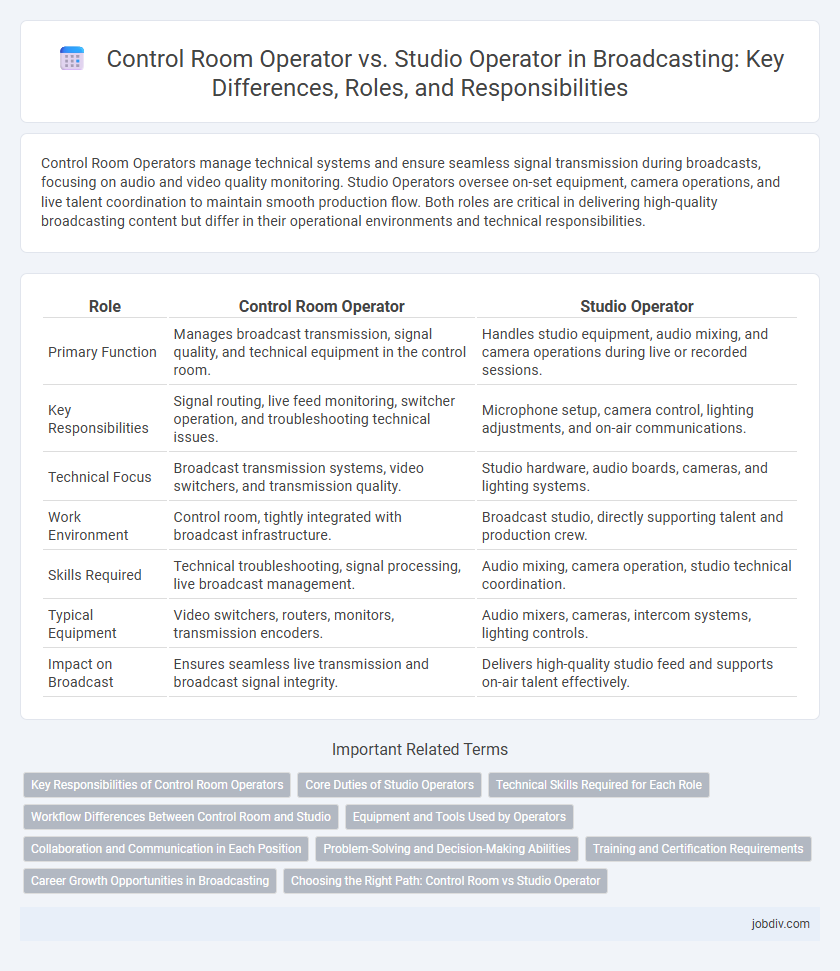Control Room Operators manage technical systems and ensure seamless signal transmission during broadcasts, focusing on audio and video quality monitoring. Studio Operators oversee on-set equipment, camera operations, and live talent coordination to maintain smooth production flow. Both roles are critical in delivering high-quality broadcasting content but differ in their operational environments and technical responsibilities.
Table of Comparison
| Role | Control Room Operator | Studio Operator |
|---|---|---|
| Primary Function | Manages broadcast transmission, signal quality, and technical equipment in the control room. | Handles studio equipment, audio mixing, and camera operations during live or recorded sessions. |
| Key Responsibilities | Signal routing, live feed monitoring, switcher operation, and troubleshooting technical issues. | Microphone setup, camera control, lighting adjustments, and on-air communications. |
| Technical Focus | Broadcast transmission systems, video switchers, and transmission quality. | Studio hardware, audio boards, cameras, and lighting systems. |
| Work Environment | Control room, tightly integrated with broadcast infrastructure. | Broadcast studio, directly supporting talent and production crew. |
| Skills Required | Technical troubleshooting, signal processing, live broadcast management. | Audio mixing, camera operation, studio technical coordination. |
| Typical Equipment | Video switchers, routers, monitors, transmission encoders. | Audio mixers, cameras, intercom systems, lighting controls. |
| Impact on Broadcast | Ensures seamless live transmission and broadcast signal integrity. | Delivers high-quality studio feed and supports on-air talent effectively. |
Key Responsibilities of Control Room Operators
Control Room Operators manage the technical aspects of broadcasting, including monitoring audio levels, switching video feeds, and ensuring signal integrity during live transmissions. Their key responsibilities also involve troubleshooting equipment malfunctions and coordinating with on-air talent to maintain seamless broadcast quality. In contrast, Studio Operators primarily focus on managing studio equipment and facilitating live production elements within the studio environment.
Core Duties of Studio Operators
Studio Operators manage on-air equipment, ensuring smooth live broadcasts and seamless transitions between segments. They monitor audio and video quality, adjusting levels in real-time to maintain production standards. Their core duties include coordinating with talent, cueing video playback, and managing communication lines within the studio environment.
Technical Skills Required for Each Role
Control Room Operators require expertise in video switchers, audio mixing consoles, and signal routing equipment to manage live broadcast feeds seamlessly. Studio Operators must excel in camera operation, lighting control, and teleprompter management to ensure smooth in-studio productions. Both roles demand proficiency in troubleshooting technical issues, but Control Room Operators focus more on signal flow and broadcast transmission, while Studio Operators specialize in on-set equipment coordination and live direction.
Workflow Differences Between Control Room and Studio
Control Room Operators manage the technical workflow, including signal routing, audio mixing, and live broadcast monitoring, ensuring seamless transmission and compliance with broadcast standards. Studio Operators focus on the creative workflow, coordinating talent, managing cameras, lighting, and on-set audio to capture high-quality visuals and sound during production. The control room emphasizes real-time broadcast execution, while the studio centers on the production and content creation phase.
Equipment and Tools Used by Operators
Control Room Operators manage complex broadcast equipment such as video switchers, audio mixers, and signal processors to ensure seamless transmission and quality control. Studio Operators handle cameras, lighting panels, and teleprompters, focusing on capturing live footage and coordinating on-set technical elements. Both roles require proficiency in specialized tools to maintain broadcast standards and deliver high-quality content.
Collaboration and Communication in Each Position
Control Room Operators ensure seamless broadcast transmission by managing audio and video signal flow, requiring precise communication with technical teams to troubleshoot live issues instantly. Studio Operators coordinate with on-air talent and production staff, focusing on cueing cameras, microphones, and lighting to align with the program's creative direction. Effective collaboration between Control Room and Studio Operators is essential for synchronizing technical operations and live production, maintaining broadcast quality and timing.
Problem-Solving and Decision-Making Abilities
Control Room Operators excel in problem-solving by managing real-time technical issues, ensuring seamless broadcast transmission through rapid decision-making and system diagnostics. Studio Operators focus on immediate content adjustments and talent coordination, requiring quick judgment to resolve on-air challenges and maintain production flow. Both roles demand strong situational awareness and the ability to make high-pressure decisions that impact broadcast quality and continuity.
Training and Certification Requirements
Control Room Operators require specialized training in broadcast signal management, equipment operation, and regulatory compliance, often obtaining certifications such as the Society of Broadcast Engineers (SBE) Certified Broadcast Technologist. Studio Operators focus on proficiency in audio and video mixing, camera operation, and live production techniques, with certifications like the National Association of Broadcasters (NAB) Digital Media Certification enhancing their credentials. Both roles necessitate continuous training to stay current with evolving broadcast technology standards and industry regulations.
Career Growth Opportunities in Broadcasting
Control Room Operators in broadcasting typically handle technical equipment, signal flow, and live broadcast quality, positioning them for career growth into senior technical roles such as broadcast engineers or technical directors. Studio Operators manage on-set equipment, coordinate talent and crew, and ensure smooth production workflows, paving the way for advancements into production management or directing. Both roles offer distinct pathways within the broadcasting industry, with Control Room Operators leaning toward technical specialization and Studio Operators toward creative leadership positions.
Choosing the Right Path: Control Room vs Studio Operator
Control Room Operators manage technical aspects of broadcast transmissions, ensuring signal quality, managing equipment, and handling live feeds, while Studio Operators focus on the operation of cameras, audio equipment, and lighting within the studio environment. Choosing between a Control Room and Studio Operator role depends on whether one prefers the behind-the-scenes technical coordination or the dynamic, on-set production experience. Mastery of broadcast automation, signal routing, and troubleshooting defines success for Control Room Operators, whereas Studio Operators require proficiency in studio equipment handling, live production cues, and real-time problem-solving.
Control Room Operator vs Studio Operator Infographic

 jobdiv.com
jobdiv.com